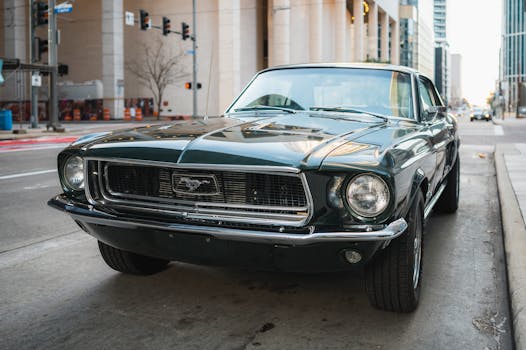Classic Cars from the 1960s

Classic cars from the 1960s hold a special place in the hearts of automobile enthusiasts. These vehicles are more than just modes of transportation; they are pieces of history that reflect the culture and engineering prowess of their time. The 1960s was a decade marked by innovation and style in the automotive industry, with manufacturers pushing the boundaries of design and performance.
The 1960s saw the introduction of some of the most iconic cars ever made, such as the Ford Mustang, Chevrolet Camaro, and Jaguar E-Type. These models not only defined an era but also set new standards for what cars could be. They were characterized by sleek lines, powerful engines, and a sense of freedom and adventure that resonated with consumers worldwide.
Owning a classic car from the 1960s is like owning a piece of history. These cars are often meticulously restored to their original glory, with attention to detail that ensures they look and perform as well as they did when they first rolled off the assembly line. Whether you're a seasoned collector or a newcomer to the world of classic cars, understanding what makes these vehicles special is essential to appreciating their enduring appeal.
Iconic Models
The 1960s were a golden age for car design, with numerous models becoming instant classics. The Ford Mustang, introduced in 1964, quickly became one of America's most beloved cars. Its combination of sporty looks and performance made it an instant hit. The Chevrolet Camaro, launched in 1966, was GM's answer to the Mustang and offered a similar blend of style and power.
European manufacturers were also making waves during this period. The Jaguar E-Type, introduced in 1961, was celebrated for its stunning design and impressive performance. Enzo Ferrari famously called it "the most beautiful car ever made." Another standout was the Porsche 911, which debuted in 1964 and has since become one of the most enduring sports cars in history.
Design and Engineering
The design philosophy of 1960s classic cars was heavily influenced by aerodynamics and aesthetics. Sleek lines, chrome accents, and bold colors were hallmarks of the era. Engineers focused on creating vehicles that were not only visually appealing but also capable of delivering exhilarating performance.
Under the hood, these cars featured powerful engines that provided impressive speed and acceleration. The V8 engine became synonymous with American muscle cars, offering substantial horsepower and torque. European models often featured smaller, yet highly efficient engines that balanced performance with handling precision.
Restoration and Maintenance
Restoring a classic car from the 1960s is both an art and a science. Enthusiasts often spend years sourcing original parts and working with skilled craftsmen to bring these vehicles back to life. The goal is to maintain authenticity while ensuring the car meets modern safety standards.
Maintenance is another crucial aspect of owning a classic car. Regular servicing, proper storage, and using high-quality parts are essential to preserving the vehicle's condition. Many owners join car clubs or online forums to share tips and advice on keeping their classics in top shape.
Investment Value
Classic cars from the 1960s are not just objects of admiration; they can also be valuable investments. Over the years, certain models have appreciated significantly in value. For example, a well-maintained Ford Mustang or Jaguar E-Type can fetch high prices at auctions.
The investment potential of classic cars is influenced by several factors, including rarity, historical significance, and condition. Collectors often seek out limited-edition models or those with unique features that set them apart from standard production runs.
Cultural Impact
The influence of 1960s classic cars extends beyond the automotive world; they have left an indelible mark on popular culture. Movies like "Bullitt" featuring Steve McQueen's iconic chase scene with a Ford Mustang GT have cemented these cars' legendary status.
Music from the era also celebrated car culture. Songs like "Little Deuce Coupe" by The Beach Boys captured the spirit of youth and freedom associated with driving these powerful machines. Classic cars have become symbols of an era defined by innovation, rebellion, and style.
| Model | Year Introduced | Notable Features |
|---|---|---|
| Ford Mustang | 1964 | Sleek design, V8 engine options |
| Chevrolet Camaro | 1966 | Aggressive styling, high performance |
| Jaguar E-Type | 1961 | Aerodynamic design, inline-six engine |
| Porsche 911 | 1964 | Rear-engine layout, iconic shape |
The Community Aspect
The community surrounding classic cars from the 1960s is vibrant and welcoming. Car shows, rallies, and club meetings offer enthusiasts opportunities to showcase their vehicles and share their passion with like-minded individuals. These events often feature competitions where owners can win awards for best restoration or most original vehicle.
Online communities have also flourished in recent years. Websites like Hemmings.com provide forums where enthusiasts can discuss everything from restoration techniques to upcoming events. Social media platforms have further expanded these connections, allowing for real-time sharing of photos and experiences.
The allure of classic cars from the 1960s remains strong decades after their initial release. These vehicles represent a unique blend of design ingenuity and cultural significance that continues to captivate enthusiasts around the world. Whether you're drawn to their aesthetic beauty or their engineering brilliance, there's no denying that these classics hold a timeless appeal.
If you find yourself fascinated by these automotive icons, consider attending a local car show or joining an online forum to connect with other enthusiasts. Owning or simply appreciating a classic car from this era offers a glimpse into a time when innovation ruled the roadways, making every drive an unforgettable experience.